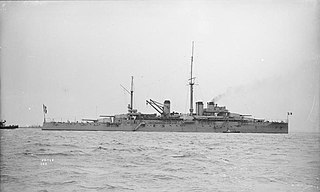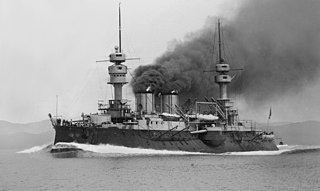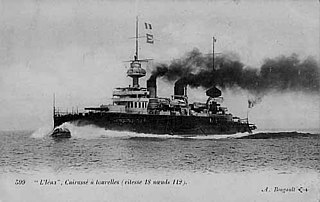
France was the last of four Courbet-class battleships, the first dreadnoughts built for the French Navy. The ship was completed just before the start of World War I in August 1914. Even though France was not officially completed, she ferried the President of France to Russia during the July Crisis for consultations. She spent the war providing cover for the Otranto Barrage that blockaded the Austro-Hungarian Navy in the Adriatic Sea and sometimes served as a flagship. After the war France and her sister ship Jean Bart participated in the occupation of Constantinople and were then sent to the Black Sea in 1919 to support Allied troops in the Southern Russia Intervention. The war-weary crews of both ships briefly mutinied, but it was easily put down and she returned to France mid-year. Striking an uncharted rock off the French coast in 1922, she foundered four hours later.

The Normandie class consisted of five dreadnought battleships ordered for the French Navy in 1912–1913. It comprised Normandie, the lead ship, Flandre, Gascogne, Languedoc, and Béarn. The design incorporated a radical arrangement for the twelve 340 mm (13.4 in) main battery guns: three quadruple-gun turrets, the first of their kind, as opposed to the twin-gun turrets used by most other navies. The first four ships were also equipped with an unusual hybrid propulsion system that used both steam turbines and triple-expansion steam engines to increase fuel efficiency.
The Canadian Surface Combatant, formerly the Single Class Surface Combatant Project is the name given to the procurement project that will replace the Iroquois and Halifax-class warships with up to 15 new ships beginning in the mid to late 2020s as part of the National Shipbuilding Procurement Strategy.

Masséna was a pre-dreadnought battleship of the French Navy, built in the 1890s. She was a member of a group of five broadly similar battleships, along with Charles Martel, Jauréguiberry, Bouvet, and Carnot, that were ordered in response to the British Royal Sovereign class. She was named in honour of Marshal of France André Masséna. Masséna significantly exceeded her design weight and suffered from serious stability problems that inhibited accurate firing of her guns; as a result, she was considered to be an unsuccessful design.

Courbet was the lead ship of her class of four dreadnought battleships, the first ones built for the French Navy. She was completed shortly before the start of World War I in August 1914. She spent the war in the Mediterranean, where she helped to sink an Austro-Hungarian cruiser, covered the Otranto Barrage that blockaded the Austro-Hungarian Navy in the Adriatic Sea, and often served as a flagship. Although upgraded several times before World War II, she was not considered to be a first-line battleship by the 1930s and spent much of that decade as a gunnery training ship.

The Lyon class was a set of battleships planned for the French Navy in 1913, with construction scheduled to begin in 1915. The class was to have comprised four ships, named Lyon, Lille, Duquesne, and Tourville. The first two were named for cities in France, and the latter pair honored the French admirals Abraham Duquesne and Anne Hilarion de Tourville. The Lyon class' design was an improvement on the previous Normandie class, utilizing a fourth quadruple-gun turret to mount a total of sixteen 34 cm (13.4 in) guns. Construction on the Lyons was cancelled due to the August 1914 outbreak of World War I, before any of the ships were laid down.

Jauréguiberry was a pre-dreadnought battleship constructed for the French Navy in the 1890s. Built in response to a naval expansion program of the British Royal Navy, she was one of a group of five roughly similar battleships, including Masséna, Bouvet, Carnot, and Charles Martel. Jauréguiberry was armed with a mixed battery of 305 mm (12 in), 274 mm (10.8 in) and 138 mm (5.4 in) guns. Constraints on displacement imposed by the French naval command produced a series of ships that were significantly inferior to their British counterparts, suffering from poor stability and a mixed armament that was difficult to control in combat conditions.

The Liberté class consisted of four pre-dreadnought battleships built for the French Navy in the early 1900s. The class comprised Liberté, Justice, Vérité, and Démocratie. They were ordered as part of a naval expansion program directed at countering German warship construction authorized by the German Naval Law of 1898; the French program called for six new battleships, which began with the two République-class battleships. During construction of the first two vessels, foreign adoption of heavier secondary batteries prompted the French to re-design the last four members to carry a secondary battery of 194 mm (7.6 in) guns, producing the Liberté class. Like the Républiques, their main armament consisted of four 305 mm (12 in) guns in two twin-gun turrets.

Iéna was a pre-dreadnought battleship built for the French Navy. Completed in 1902, Iéna was assigned to the Mediterranean Squadron and remained there for the duration of her career, frequently serving as a flagship. She participated in the annual fleet manoeuvres and made many visits to French ports in the Mediterranean. In 1907, while docked for repairs, 120 people died and Iéna was badly damaged by a magazine explosion that was probably caused by the decomposition of old Poudre B propellant. Multiple investigations were launched afterwards and the ensuing scandal forced the Navy Minister to resign. While it was possible to repair her, the ship was not thought worth the time or expense. Her salvaged hulk was used as a gunnery target in 1909 before it was sold for scrap in 1912.

The République class consisted of a pair of pre-dreadnought battleships—République, the lead ship, and Patrie—built for the French Navy in the early 1900s. They were ordered as part of a naval expansion program directed at countering German warship construction authorized by the German Naval Law of 1898. The French program called for six new battleships, the last four became the very similar Liberté class. République and Patrie, designed by Louis-Émile Bertin, were a significant improvement over previous French battleships. They carried a similar offensive armament of four 305 mm (12 in) guns and eighteen 164 mm (6.5 in) guns, though most of the 164 mm guns were now mounted in more flexible gun turrets rather than in casemates, and they had a much more effective armor protection arrangement that remedied the tendency of earlier battleships to lose stability from relatively minor damage.

Carnot was a pre-dreadnought battleship of the French Navy. She was laid down in July 1891, launched in July 1894, and completed in July 1897. She was a member of a group of five broadly similar battleships, along with Charles Martel, Jauréguiberry, Bouvet, and Masséna, which were ordered in response to the British Royal Sovereign class. Like her half-sisters, she was armed with a main battery of two 305 mm (12.0 in) guns and two 274 mm (10.8 in) guns in individual turrets. She had a top speed of 17.8 knots.

Charles Martel was a pre-dreadnought battleship of the French Navy built in the 1890s. She was laid down in August 1891, launched in August 1893, and commissioned into the fleet in June 1897. She was a member of a group of five broadly similar battleships ordered as part of the French response to a major British naval construction program. The five ships were built to the same basic design parameters, though the individual architects were allowed to deviate from each other in other details. Like her half-sisters—Carnot, Jauréguiberry, Bouvet, and Masséna—she was armed with a main battery of two 305 mm (12.0 in) guns and two 274 mm (10.8 in) guns. She had a top speed of 18 knots.

Brennus was the first pre-dreadnought battleship built for the Marine Nationale. Completed in 1896, she was a unique ironclad battleship, with a main battery of heavy guns mounted on the centerline and the first use of Belleville boilers. She formed the basis for several subsequent designs, beginning with Charles Martel. As completed in 1893, the ship was very top-heavy and had to be rebuilt over the next three years before she was ready to enter service.
The Charles Martel class was a planned class of ironclad barbette ships of the French Navy. The class comprised two ships, Charles Martel and Brennus, and represented an incremental improvement over the preceding Marceau class, being larger, but carrying the same main battery of four 340 mm (13.4 in) guns in single mounts. Details of the ships' construction are unclear and contradictory, with various sources reporting that both ships were laid down, or that only Brennus was begun; neither ship was launched before they were cancelled in 1884 or 1886. Some sources indicate that Brennus was redesigned and completed as France's first pre-dreadnought battleship, Brennus, but most other historians dispute the idea.

Léon Gambetta was the lead ship of her class of three armored cruisers built for the French Navy in the first decade of the 20th century. Armed with four 194-millimeter (7.6 in) guns, the ships were much larger and more powerfully armed than their predecessors. Completed in 1905, she was initially assigned to the Northern Squadron where she served as a flagship. The ship was transferred to the Mediterranean Squadron in 1910 and remained there for the rest of her career.

The Dupleix class consisted of three armored cruisers built for the French Navy at the beginning of the 20th century. Designed for overseas service and armed with four 164.7-millimeter (6.5 in) guns, the three ships of the class were smaller and less powerfully armed than their predecessors.

D'Entrecasteaux, later ORP Bałtyk was a French protected cruiser. She was laid down in June 1894 at Forges et Chantiers de la Méditerranée, La Seyne, launched on 12 June 1896 and completed in 1898. After serving as the French flagship in the Far East, D'Entrecasteaux served in the eastern Mediterranean during World War I against the Ottoman Empire. After the war, she briefly served in the Belgian Navy before being sold to the recently restored Poland for its new navy. She was eventually scrapped in 1942 following the German invasion of Poland.

Cosmao was the third and final member of the Troude class of protected cruisers built for the French Navy in the late 1880s and early 1890s. The class was built as part of a construction program intended to provide scouts for the main battle fleet. They were based on the preceding Forbin class, the primary improvement being the addition of armor to the conning tower. Cosmao was built in the 1880s and was completed in 1890. She was armed with a main battery of four 138 mm (5.4 in) guns, protected with an armor deck that was 41 mm (1.6 in) thick, and had a top speed of 20.5 knots.
The Conseil supérieur de la Marine was an advisory body to the Minister of the Navy that was formed on 5 December 1889. It consisted of the Chief of the Naval Staff, the Directeur du matérial, the Directeur de l'artillerie and various admirals. "The CSM advised the minister on the military characteristics of new designs and drew up the staff requirements including displacement, offensive/defensive qualities, speed and endurance."